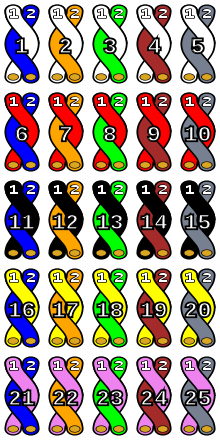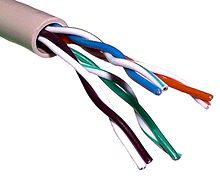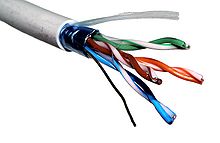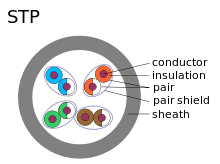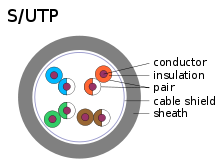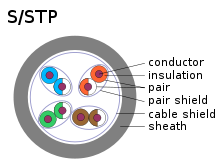- Twisted pair
-
Twisted pair cabling is a type of wiring in which two conductors (the forward and return conductors of a single circuit) are twisted together for the purposes of canceling out electromagnetic interference (EMI) from external sources; for instance, electromagnetic radiation from unshielded twisted pair (UTP) cables, and crosstalk between neighboring pairs. It was invented by Alexander Graham Bell.
Contents
Explanation
In balanced pair operation, the two wires carry equal and opposite signals and the destination detects the difference between the two. This is known as differential mode transmission. Noise sources introduce signals into the wires by coupling of electric or magnetic fields and tend to couple to both wires equally. The noise thus produces a common-mode signal which is cancelled at the receiver when the difference signal is taken. This method starts to fail when the noise source is close to the signal wires; the closer wire will couple with the noise more strongly and the common-mode rejection of the receiver will fail to eliminate it. This problem is especially apparent in telecommunication cables where pairs in the same cable lie next to each other for many miles. One pair can induce crosstalk in another and it is additive along the length of the cable. Twisting the pairs counters this effect as on each half twist the wire nearest to the noise-source is exchanged. Providing the interfering source remains uniform, or nearly so, over the distance of a single twist, the induced noise will remain common-mode. Differential signaling also reduces electromagnetic radiation from the cable, along with the associated attenuation allowing for greater distance between exchanges.
The twist rate (also called pitch of the twist, usually defined in twists per meter) makes up part of the specification for a given type of cable. Where nearby pairs have equal twist rates, the same conductors of the different pairs may repeatedly lie next to each other, partially undoing the benefits of differential mode. For this reason it is commonly specified that, at least for cables containing small numbers of pairs, the twist rates must differ.[1]
In contrast to FTP (foiled twisted pair) and STP (shielded twisted pair) cabling, UTP (unshielded twisted pair) cable is not surrounded by any shielding. It is the primary wire type for telephone usage and is very common for computer networking, especially as patch cables or temporary network connections due to the high flexibility of the cables.
History
The earliest telephones used telegraph lines, or open-wire single-wire earth return circuits. In the 1880s electric trams were installed in many cities, which induced noise into these circuits. Lawsuits being unavailing, the telephone companies converted to balanced circuits, which had the incidental benefit of reducing attenuation, hence increasing range.
As electrical power distribution became more commonplace, this measure proved inadequate. Two wires, strung on either side of cross bars on utility poles, shared the route with electrical power lines. Within a few years the growing use of electricity again brought an increase of interference, so engineers devised a method called wire transposition, to cancel out the interference. In wire transposition, the wires exchange position once every several poles. In this way, the two wires would receive similar EMI from power lines. This represented an early implementation of twisting, with a twist rate of about four twists per kilometre, or six per mile. Such open-wire balanced lines with periodic transpositions still survive today in some rural areas.
Twisted pair cables were invented by Alexander Graham Bell in 1881.[2] By 1900, the entire American telephone line network was either twisted pair or open wire with transposition to guard against interference. Today, most of the millions of kilometres of twisted pairs in the world are outdoor landlines, owned by telephone companies, used for voice service, and only handled or even seen by telephone workers.
Unshielded twisted pair (UTP)
UTP cables are found in many Ethernet networks and telephone systems. For indoor telephone applications, UTP is often grouped into sets of 25 pairs according to a standard 25-pair color code originally developed by AT&T. A typical subset of these colors (white/blue, blue/white, white/orange, orange/white) shows up in most UTP cables.
For urban outdoor telephone cables containing hundreds or thousands of pairs, the cable is divided into smaller but identical bundles. Each bundle consists of twisted pairs that have different twist rates. The bundles are in turn twisted together to make up the cable. Pairs having the same twist rate within the cable can still experience some degree of crosstalk. Wire pairs are selected carefully to minimize crosstalk within a large cable.
UTP cable is also the most common cable used in computer networking. Modern Ethernet, the most common data networking standard, utilizes UTP cables. Twisted pair cabling is often used in data networks for short and medium length connections because of its relatively lower costs compared to optical fiber and coaxial cable.
UTP is also finding increasing use in video applications, primarily in security cameras. Many middle to high-end cameras include a UTP output with setscrew terminals. This is made possible by the fact that UTP cable bandwidth has improved to match the baseband of television signals. While the video recorder most likely still has unbalanced BNC connectors for standard coaxial cable, a balun is used to convert from 100-ohm balanced UTP to 75-ohm unbalanced. A balun can also be used at the camera end for ones without a UTP output. Only one pair is necessary for each video signal.
Cable shielding
Twisted pair cables are often shielded in an attempt to prevent electromagnetic interference. Because the shielding is made of metal, it may also serve as a ground. However, usually a shielded or a screened twisted pair cable has a special grounding wire added called a drain wire. This shielding can be applied to individual pairs, or to the collection of pairs. When shielding is applied to the collection of pairs, this is referred to as screening. The shielding must be grounded for the shielding to work, and is improved by grounding the drain wire along with the shield.
- Shielded twisted pair (STP or STP-A)
- 150 ohm STP shielded twisted pair cable defined by the IBM Cabling System specifications and used with token ring or FDDI networks. This type of shielding protects cable from external EMI from entering or exiting the cable and also protects neighboring pairs from crosstalk.
- Screened twisted pair (ScTP or F/TP)
- ScTP cabling offers an overall sheath shield across all of the pairs within the 100 Ohm[3] twisted pair cable. F/TP uses foil shielding instead of a braided screen. This type of shielding protects EMI from entering or exiting the cable.
- Screened shielded twisted pair (S/STP or S/FTP)
- S/STP (Screened Shielded Twisted Pair) or S/FTP (Screened Foiled Twisted Pair) cabling offer shielding between the pair sets and an overall sheath shield within the 100 Ohm twisted pair cable. This type of shielding protects EMI from entering or exiting the cable and also protects neighboring pairs from crosstalk.
S/STP cable[4] is both individually shielded (like STP cabling) and also has an outer metal shielding covering the entire group of shielded copper pairs (like S/UTP). This type of cabling offers the best protection from interference from external sources, and also eliminates alien crosstalk.[4]
Note that different vendors and authors use different terminology (i.e. STP has been used to denote both STP-A, S/STP, and S/UTP).[3] See below for the ISO/IEC attempt to internationally standardise the various designations.
Comparison of some old and new abbreviations, according to ISO/IEC 11801:Old name New name cable screening pair shielding UTP U/UTP none none STP U/FTP none foil FTP F/UTP foil none S-STP S/FTP braiding foil S-FTP SF/UTP foil, braiding none The code before the slash designates the shielding for the cable itself, while the code after the slash determines the shielding for the individual pairs:
- TP = twisted pair
- U = unshielded
- F = foil shielding
- S = braided shielding
Most common cable categories
Category Type Frequency Bandwidth Applications Notes Cat1 0.4 MHz Telephone and modem lines Not described in EIA/TIA recommmendations. Unsuitable for modern systems.[5] Cat2 ? MHz Older terminal systems, e.g. IBM 3270 Not described in EIA/TIA recommmendations. Unsuitable for modern systems.[5] Cat3 UTP[6] 16MHz[6] 10BASE-T and 100BASE-T4 Ethernet[6] Described in EIA/TIA-568. Unsuitable for speeds above 16 Mbit/s. Now mainly for telephone cables[6] Cat4 UTP[6] 20MHz[6] 16 Mbit/s[6] Token Ring Not commonly used[6] Cat5 UTP[6] 100MHz[6] 100BASE-TX & 1000BASE-T Ethernet[6] Common in most current LANs[6] Cat5e UTP[6] 100MHz[6] 100BASE-TX & 1000BASE-T Ethernet[6] Enhanced Cat5. Same construction as Cat5, but with better testing standards. Cat6 UTP[6] 250MHz[6] 1000BASE-T Ethernet Most commonly installed cable in Finland according to the 2002 standard. SFS-EN 50173-1 Cat6e 250MHz (500MHz according to some)[who?] Not a standard; a cable maker's own label. Cat6a 500MHz 10GBASE-T Ethernet ISO/IEC 11801:2002 Amendment 2. Cat7 S/FTP[6] 600MHz[6] Telephone, CCTV, 1000BASE-TX in the same cable. 10GBASE-T Ethernet. Four pairs, S/FTP (shielded pairs, braid-screened cable). Development complete - ISO/IEC 11801 2nd Ed. Cat7a 1000MHz Telephone, CATV, 1000BASE-TX in the same cable. 10GBASE-T Ethernet. Four pairs, S/FTP (shielded pairs, braid-screened cable). Development complete - ISO/IEC 11801 2nd Ed. Am. 2. Cat8 1200MHz Under development, no applications yet. Four pairs, S/FTP (shielded pairs, braid-screened cable). Standard under development. Solid core cable vs stranded cable
A solid core cable uses one solid wire per conductor and in a four pair cable there would be a total of eight solid wires.[6] Stranded conductor uses multiple wires wrapped around each other in each conductor and in a four pair with seven strands per conductor cable, there would be a total of 56 wires.[6]
Solid core cable is supposed to be used for permanently installed runs. It is less flexible than stranded cable and is more prone to failure if repeatedly flexed. Stranded cable is used for fly leads at patch panel and for connections from wall-ports to end devices, as it resists cracking of the conductors. Stranded core is generally more expensive than solid core.
Connectors need to be designed differently for solid core than for stranded. Use of a connector with the wrong cable type is likely to lead to unreliable cabling. Plugs designed for solid and stranded core are readily available, and some vendors even offer plugs designed for use with both types. The punch-down blocks on patch-panel and wall port jacks are designed for use with solid core cable.
Advantages
- It is a thin, flexible cable that is easy to string between walls.
- More lines can be run through the same wiring ducts.
- UTP costs less per meter/foot than any other type of LAN cable.
- Electrical noise going into or coming from the cable can be prevented.[7]
- Cross-talk is minimized.[7]
Disadvantages
- Twisted pair’s susceptibility to electromagnetic interference greatly depends on the pair twisting schemes (usually patented by the manufacturers) staying intact during the installation. As a result, twisted pair cables usually have stringent requirements for maximum pulling tension as well as minimum bend radius. This relative fragility of twisted pair cables makes the installation practices an important part of ensuring the cable’s performance.
- In video applications that send information across multiple parallel signal wires, twisted pair cabling can introduce signaling delays known as skew which results in subtle color defects and ghosting due to the image components not aligning correctly when recombined in the display device. The skew occurs because twisted pairs within the same cable often use a different number of twists per meter so as to prevent common-mode crosstalk between pairs with identical numbers of twists. The skew can be compensated by varying the length of pairs in the termination box, so as to introduce delay lines that take up the slack between shorter and longer pairs, though the precise lengths required are difficult to calculate and vary depending on the overall cable length.
Minor twisted pair variants
- Loaded twisted pair: A twisted pair that has intentionally added inductance, common practice on telecommunication lines, except those carrying higher than voiceband frequencies. The added inductors are known as load coils and reduce distortion.
- Unloaded twisted pair: A twisted pair that has no added load coils.
- Bonded twisted pair: A twisted pair variant in which the pairs are individually bonded to increase robustness of the cable. Pioneered by Belden, it means the electrical specifications of the cable are maintained despite rough handling.
- Twisted ribbon cable: A variant of standard ribbon cable in which adjacent pairs of conductors are bonded and twisted together. The twisted pairs are then lightly bonded to each other in a ribbon format. Periodically along the ribbon there are short sections with no twisting to enable connectors and pcb headers to be terminated using the usual ribbon cable IDC techniques.
See also
- Balanced line
- Category 5 cable
- Ethernet over twisted pair
- Litz wire
- Registered jack
- TIA/EIA-568-B
- Tip and ring
References
- ^ "Crosstalk dependence on number of turns/inch for twisted pair versions of the endcap umbilical cable". http://www.hep.ph.ic.ac.uk/~dmray/pdffiles/TP_umbilical_studies.pdf.
- ^ US 244426, Bell, Alexander Graham, "Telephone-circuit", issued 1881. See also TIFF format scans for USPTO 00244426
- ^ a b Anitech Systems MP 4000 Manual
- ^ a b Grounding for Screened and Shielded Network Cabling - Siemon
- ^ a b "CCNA: Network Media Types". http://www.ciscopress.com/articles/article.asp?p=31276.
- ^ a b c d e f g h i j k l m n o p q r s t u "Comparison between CAT5, CAT5e, CAT6, CAT7 Cables". http://discountcablesusa.com/ethernet-cables100.html.
- ^ a b "Twisted Pair Testing". http://www.cirris.com/testing/twisted_pair/twist.html.
External links
Unshielded and shielded twisted pair cabling standards Categories Categories:- Communication circuits
- Video hardware
- Electromagnetic compatibility
- Cables
Wikimedia Foundation. 2010.

